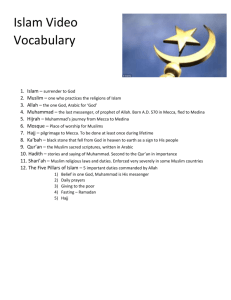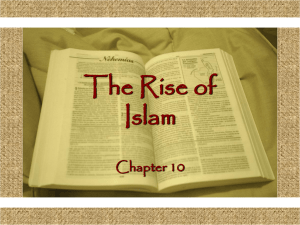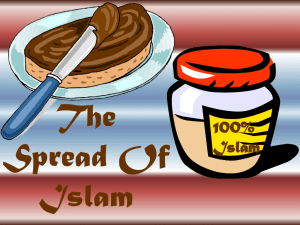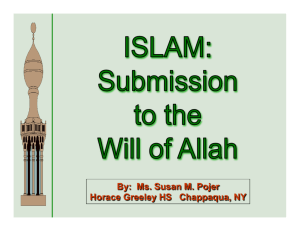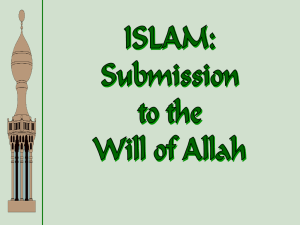The Muslim World, 600-1250: Chapter Summary
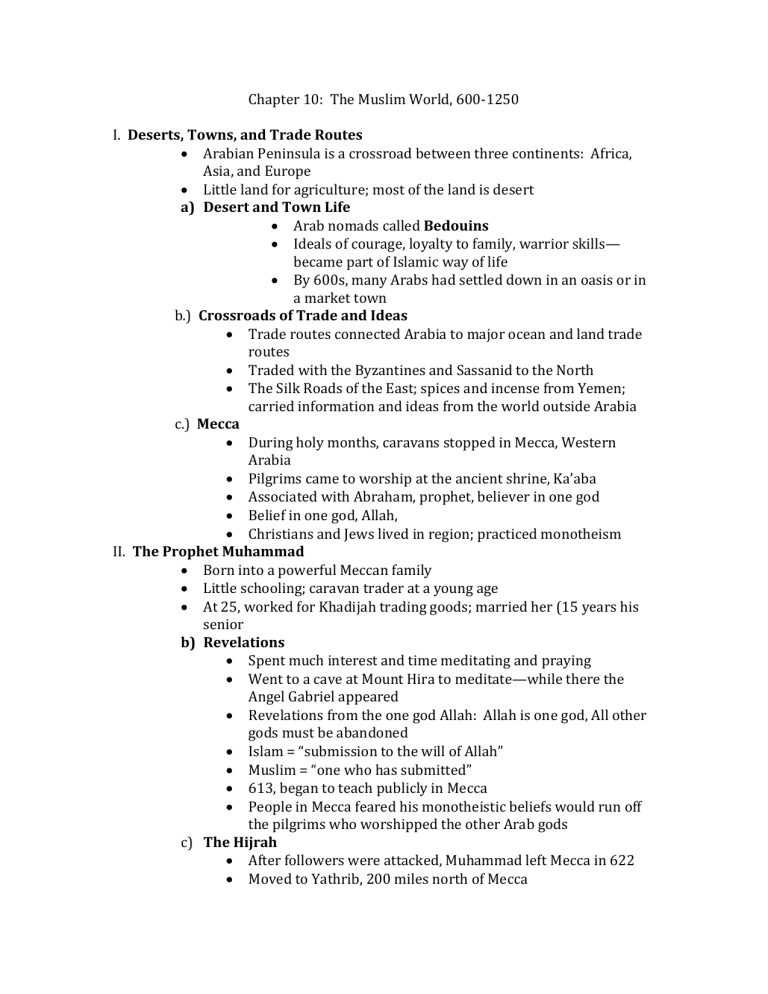
Chapter 10: The Muslim World, 600-1250
I. Deserts, Towns, and Trade Routes
Arabian Peninsula is a crossroad between three continents: Africa,
Asia, and Europe
Little land for agriculture; most of the land is desert a) Desert and Town Life
Arab nomads called Bedouins
Ideals of courage, loyalty to family, warrior skills— became part of Islamic way of life
By 600s, many Arabs had settled down in an oasis or in a market town
b.) Crossroads of Trade and Ideas
Trade routes connected Arabia to major ocean and land trade routes
Traded with the Byzantines and Sassanid to the North
The Silk Roads of the East; spices and incense from Yemen; carried information and ideas from the world outside Arabia
c.) Mecca
During holy months, caravans stopped in Mecca, Western
Arabia
Pilgrims came to worship at the ancient shrine, Ka’aba
Associated with Abraham, prophet, believer in one god
Belief in one god, Allah,
Christians and Jews lived in region; practiced monotheism
II. The Prophet Muhammad
Born into a powerful Meccan family
Little schooling; caravan trader at a young age
At 25, worked for Khadijah trading goods; married her (15 years his senior b) Revelations
Spent much interest and time meditating and praying
Went to a cave at Mount Hira to meditate—while there the
Angel Gabriel appeared
Revelations from the one god Allah: Allah is one god, All other gods must be abandoned
Islam = “submission to the will of Allah”
Muslim = “one who has submitted”
613, began to teach publicly in Mecca
People in Mecca feared his monotheistic beliefs would run off the pilgrims who worshipped the other Arab gods c) The Hijrah
After followers were attacked, Muhammad left Mecca in 622
Moved to Yathrib, 200 miles north of Mecca
Migration known as Hijrah, later changed to Medina; marks first year of Muslim calendar
Muhammad improved his leadership skills
Joined his people, Arabs, and Jews into a single community in
Medina
Many converts; became military leader in the growing conflict between Mecca and Medina d) Returning to Mecca
In 630, Muhammad and 10,000 followers marched on Mecca
Meccan leaders surrender; all idols destroyed in Ka’aba; now a mosque
Many Meccans pledged loyalty and joined umma—Muslim religious community
Two years later, Muhammad dies; unified the entire Arabian
Peninsula under Islam
III. Beliefs and Practices of Islam
Only one god, Allah; there is good and evil; each individual is responsible for the actions of his or her life e) The Five Pillars
Faith—profess the faith
Prayer—pray 5 times daily
Alms—give alms to the poor
Fasting—during the holy month of Ramadan
Pilgrimage—make a Hajj to Mecca f) A Way of Life
Five pillars ensure Muslims live their religion while serving their community
Rituals and customs: no eating pork, no intoxicating beverages, Fridays are communal worship, no priests/central religious authority, worship Allah directly g) Sources of Authority
Allah expressed his will through the angel Gabriel, who revealed it to Muhammad
Followers memorized and recited the revelations
Collected in a book called the Qur’an, the holy book of the
Muslims
Written in Arabic; this version considered the true word of
Allah; only Arabic can be used in worship
Muslims believe that Muhammad’s mission as a prophet was to receive the Qur’an and to demonstrate how to apply it in life
Sunna = Muhammad’s example, or the best model for proper living
Guidance of Qur’an and Sunna assembled creates the body of law known as shari’a—regulates family life, moral conduct, and community life of Muslims h) Links to Judaism and Christianity
All three religions share the same God
Jesus was a prophet, not the Son of God
People regard the Qur’an the same as the Torah and the
Gospels—the word of God
Muhammad is the final prophet
All three believe in a heaven, hell, and final judgement
All three trace their ancestry to Abraham
Qur’an regards Christians and Jews as “people of the book”, to be extended religious tolerance
IV. Muhammad’s Successors Spread Islam
Muhammad did not have a successor and left no instructions on how to choose one
Abu-Bakr, loyal friend of Muhammad, becomes first caliph—
“successor” or “deputy” a) “Rightly Guided” Caliphs
Abu-Bakr and next three elected Caliphs—Umar, Uthman, and
Ali—all used the Qur’an and Muhammad’s actions as guides to leadership
After Muhammad died, many abandoned Islam
Abu-Bakr invoked jihad, meaning “striving”—the inner struggle against evil or struggle against non-believers.
Abu-Bakr uses this as the justification to expand Islam
Dies in 634, Muslim state controlled all of Arabia; eventually
Syria, lower Egypt, and part of the Byzantine Empire
By 750, Muslim Empire stretched 6000 miles from the Atlantic
Ocean to the Indus River b) Reasons for Success
Muhammad desired to spread Islam to the North
Muslim armies were well disciplined coupled with the weakness of the exhausted Byzantine and Sassanid militaries
Persecuted people in the Byzantine and Sassanid regions, welcomed the invaders and accepted Islam; did not support
Christianity or Zoroastrianism
Islam offered equality and hope, which was attractive to many c) Treatment of Conquered People
Qur’an forbids forced conversion; conquered people were allowed to worship their own religion
Christians and Jews paid a poll tax with restrictions; they were not allowed to spread their religion
V. Internal Conflict Creates a Crisis
In 656, the Muslim community had trouble maintaining a unified rule
Civil wars will break out between various groups struggling for power
Elective system for electing a caliph will end with the assassination of
Ali—Muhammad’s cousin.
Umayyads move the capital city from Mecca to Damascus; easier now to rule the region but Arab Muslims upset.
Simple life of caliph replaced by Umayyad extravagance d) Sunni-Shi’a Split
To keep the peace, many accepted Umayyad rule
A minority group wanted the caliph to be a descendant of the
Prophet—this group is the Shi’a, or “party” of Ali—Shi’ites
Those who did not resist Umayyad rule were known as the
Sunni—followers of Muhammad’s example
Sufi rejected luxury and lived life of poverty and devotion to the spiritual path
Political opposition led to the Umayyad downfall and Abbasid take over in 750.
VI. Control Extends Over Three Continents e) Abbasids Consolidate Power
Abbasids solidify power by moving the capital to Baghdad
(central Iraq) in 762.
Location gave caliph access to trade goods, gold, and information
Developed strong bureaucracy to conduct business, taxation, and governmental affairs f) Rival Groups Divide Muslim Lands
Abbasid caliphate lasts from 750-1258
Independent Muslim states spring up from incomplete control; local leaders begin to dominate smaller regions
Fatimid caliphate forms from Shi’a Muslims who claimed descent from Muhammad’s daughter Fatima
North Africa—to Western Arabia and Syria
Still connected to the Abbasids through religion, language, and trade g) Muslim Trade Network
Two major sea trading networks existed—Mediterranean Sea and the Indian Ocean
Muslims could engage with the rest of the world
Connected Silk Roads of China and India with Europe and
Africa
To encourage trade, Muslim money changers set up banks in cities and letters of credit called sakks
Could exchange for cash in any city in the empire; first check.
VII. Muslim Society h) The Rise of Muslim Cities
Until Baghdad built, Damascus was the cultural center of
Islamic learning; Cordoba, Cairo, and Jerusalem—symbolized the strength of caliphate
Baghdad’s population approached 1 million at its peak i) Four Social Classes
Upper class—Muslims at birth
Converts to Islam
Protected people—Christians, Jews, Zoroastrians
Slaves—prisoners of war; non-Muslims j) Role of Women
Men are managers of women’s affairs; women obedient to men
Qur’an declares that men and women are equal
Shari’a law gives women legal rights in marriage, family, and property—more than you see in China, India, and Europe of the same time
Still have to submit to men; over time began to live increasingly isolated lives (veils)
VIII. Muslim Scholarship Extends Knowledge
Reliance on mathematics and astronomers to calculate times of prayer and direction of Mecca
Attitude reflected a curiosity about the world and quest for truth;
Muhammad believed in the power of learning
After fall of Rome, A.D. 476, Umayyads and Abbasids encouraged translation of philosophical texts
House of Wisdom, Baghdad—combination library, academy, and translation center.
IX. Arts and Sciences Flourish k) Muslim Literature
The Qur’an is the standard for all Arabic literature and poetry
During Abbasid caliphate, tastes began to expand to poems about nature, life, and love
The Thousand and One Nights—collection of fairy tales, parables, and legends; linked to India and Persia, but Muslims added to it (10 th Century) l) Muslim Art and Architecture
Muslims believed that only Allah can create life; images of living beings was discouraged.
Artists turned to calligraphy, the art of beautiful handwriting
Great Mosque of Damascus was built on the site of a Christian church; huge dome and vaulted ceilings blended Byzantine architecture with Muslim ideas m) Medical Advances
Al-Razi, Muslim physician, wrote a medical encyclopedia—
Comprehensive Book, which drew medical knowledge from
Greek, Syrian, Arabic, and Indian sources/ Treatise on Smallpox
and Measles n) Math and Science Stretch Horizons
Al-Khwarizmi—Baghdad mathematician writes textbook explaining “the art of bringing together unknowns to match a known quantity”
Calls this technique al-jabr, or today algebra.
X. Philosophy and Religion Blend Views
Ibn Rushd—Muslim philosopher who tried to blend Aristotle’s and
Plato’s views with those of Islam; Criticized by others for this
Stated that Greek philosophy and Islam both had the same goal: to find the truth.
